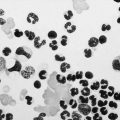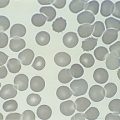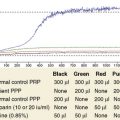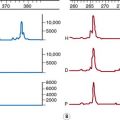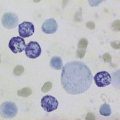Chapter 1 Collection and handling of blood
In investigating physiological function and malfunction of blood, accurate and precise methodology is essential to ensure, as far as possible, that tests do not give misleading information because of technical errors. Obtaining the specimen is the first step towards analytic procedures. It is important to use appropriate blood containers and to avoid faults in specimen collection, storage and transport to the laboratory. Venous blood is generally used for most haematological examinations and for chemistry tests; capillary skin puncture samples can be almost as satisfactory for some purposes if a free flow of blood is obtained (see p. 4), but in general this procedure should be restricted to children and to some ‘point-of-care’ screening tests which require only a drop or two of blood. Bone marrow aspirates are described in Chapter 7.
Biohazard precautions
Special care must be taken to avoid risk of infection from various pathogens during all aspects of laboratory practice, and the safety procedures described in Chapter 24 must be followed as far as possible when collecting blood. The operator should wear disposable plastic or thin rubber gloves. It is also desirable to wear a protective apron or gown, as well as glasses or goggles, if necessary. Care must be taken to prevent injuries, especially when handling syringes, needles and lancets.
Disposable sterilized syringes, needles and lancets should be used if at all possible, and they should never be re-used. Re-usable items must always be sterilized after use (see Chapter 24).
Standardized procedure
The constituents of the blood may be altered by a number of factors which are listed in Box 1.1. It is important to have a standard procedure for the collecting and handling of blood specimens. Recommendations for standardizing the procedure have been published.1–3
Venous blood
It is now common practice for specimen collection to be undertaken by specially trained phlebotomists, and there are published guidelines which set out an appropriate training programme.1,4
Phlebotomy Tray
It is convenient to have a tray which contains all the requirements for blood collection (Box 1.2).
Disposable Plastic Syringes and Disposable Needles
The needles should not be too fine, too large, or too long; those of 19 or 21G* are suitable for most adults. 23G are suitable for children and ideally should have a short shaft (about 15 mm). It may be helpful to collect the blood by means of a winged (‘butterfly’) needle connected to a length of plastic tubing which can be attached to the nozzle of the syringe or to a needle for entering the cap of an evacuated container (see below).
Specimen Containers
The common containers for haematology tests are available commercially with dipotassium, tripotassium, or disodium ethylenediaminetetra-acetic acid (EDTA) as an anticoagulant, and they are marked at a level to indicate the correct amount of blood to be added. Containers are also available containing trisodium citrate, heparin or acid-citrate-dextrose, as well as containers with no additive which are used when serum is required. Design requirements and other specifications for specimen collection containers have been described in a number of national and international standards, e.g. that of the International Council for Standardization in Haematology,5 and there is also a European standard (EN 14820). Unfortunately, there is not yet universal agreement regarding the colours for identifying containers with different additives; phlebotomists should familiarize themselves with the colours used by their own suppliers.
Phlebotomy Procedure
Blood is best withdrawn from an antecubital vein or other visible veins in the forearm by means of either an evacuated tube or a syringe. It is usually recommended that the skin should be cleaned with 70% alcohol (e.g. isopropanol) or 0.5% chlorhexidine, and allowed to dry spontaneously before being punctured; however, some doubts have been expressed on the utility of this practice for preventing infection at the venepuncture site.6 Care must also be taken when using a tourniquet to avoid contaminating it with blood because infection risks have been reported during blood collection.7 The tourniquet should be applied just above the venepuncture site and released as soon as the blood begins to flow into the syringe or evacuated tube – delay in releasing it leads to fluid shift and haemoconcentration as a result of venous blood stagnation.4 Except for very young children, it should be possible with practice to obtain venous blood even from patients with difficult veins. A butterfly needle is especially useful when a series of samples is required.
Post-phlebotomy Procedure
The phlebotomist should again check the patient’s identity and must make sure that it corresponds to the details on the request form. It is essential that every specimen, as well as the request form, is labelled with adequate patient identification immediately after the samples have been obtained. On the labels this should include at least surname and forename or initials, hospital number, date of birth and date and time of specimen collection. The same information must be given on the request form, together with ward or department, name of requesting clinician and test(s) requested. When relevant, a biohazard warning must also be affixed to the container and to the request form. If automated patient identification is available both the label and the request form should be bar-coded with the relevant data unless the sample is to be used for blood transfusion tests, in which case the label should be handwritten, with the name in full (see Chapter 21).
Stay updated, free articles. Join our Telegram channel

Full access? Get Clinical Tree


